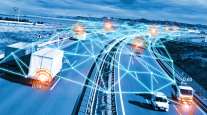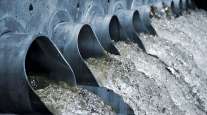Perspective: The Time to Act on Infrastructure Is Now
It is one of the greatest networks built in the history of mankind. From the Evergreen State of Washington to the Sunshine State of Florida and from the Golden State of California to the Pine Tree State of Maine — more than 45,000 miles of interstate highways connect us from coast to coast. Whether carrying food from the farm to the table, or goods from the factory floor to store shelves, interstate highways are the lifeblood of our nation’s commerce. Nearly everything and everyone travels on the interstates.

Hawkins
More than 60 years after the first mile of 24-foot-wide, 9-inch-thick portland cement was poured, the interstate system is facing a big problem. While demands on these roads continue to increase, our willingness as a nation to adequately fund this critical infrastructure network largely has failed. We have ignored the foundation of the interstate system as a national network of connections and have instead fallen into a patchwork quilt of funding solutions, state by state, or in some cases mile by mile.
Not since 1993 has Congress increased our federal fuel tax to invest in our infrastructure. One political leader who put national interest at the forefront on this issue was President Ronald Reagan. In 1982, he called on Americans to make a minor personal sacrifice and increase the federal fuel tax for an immense benefit to our national transportation network. Working across party lines with Speaker Tip O’Neill and others, a deal was cut to raise the fuel tax. They had the political courage to act in our country’s national interest. We should expect nothing less from our elected officials today.
After decades of waiting, it’s time to renew our infrastructure investment. Maybe it’s the potholes that have caught our attention as a nation. Our highways have been pummeled by hurricanes, floods, polar vortexes and bomb cyclones. Or maybe it’s the traffic and congestion. Research by the American Transportation Research Institute shows that approximately 1.2 billion hours of delays on the National Highway System are the result of traffic congestion. That’s roughly the equivalent of 425,000 commercial truck drivers sitting idle for an entire working year — an image oddly out of sync with our nation’s growing appetite for e-commerce and same-day or next-day delivery expectations in our ever-tightening supply chains.
We have a choice to make. Continue to fund the interstate system on a state-by-state or segment-by-segment basis, or support a comprehensive solution such as the one proposed by American Trucking Associations, the Build America Fund. Through a 20-cent-per-gallon user-fee increase rolled out over four years, the Build America Fund will generate $340 billion in revenue over 10 years. Unlike toll roads that have significantly higher administrative costs — up to 35% — the fuel tax is efficient to collect and administer with resulting administrative costs of 4% or less. At a time when our roads are in such disrepair, we do not need to spend our highway funds to build toll road bureaucracies, but rather roads and bridges.
Some opponents of raising the fuel tax point out that it has a limited life span as electric or alternative-fuel vehicles do not fit within the existing user-fee design. There is no doubt that advances are on the horizon. We, as an industry, need to partner with policymakers and other stakeholders to explore opportunities and find a sustainable alternative funding source for our interstate system. However, this should not get in the way of the realities we face right now. We have an immediate need to fund our interstate infrastructure. While a fuel tax is not perfect, it’s close enough for now. And it’s the best option to address a critical situation demanding immediate attention.
Sixty years and 6,500 miles from where our first mile of interstate pavement was laid, another country is making a monumental bet on its infrastructure. China is projected to invest more than $1 trillion in its Belt and Road Initiative, a massive network of highways, railways and pipelines connecting Central Asia. Why? The World Bank estimates that the investment could lift global gross domestic product by 3%. The benefactors of this increase will be found within the boundaries of that infrastructure investment.
Our interstate system has served our nation well with economic prosperity. It has permitted our farmers and factories to compete internationally. We have the personal freedom to move where we want. Now is the time to come together in a bipartisan spirit and return the favor. It’s a small investment with proven big returns. The time to act is now.
Darren Hawkins is CEO of YRC Worldwide, the holding company for less-than-truckload carriers YRC Freight, YRC Reimer, New Penn, Holland and Reddaway.




